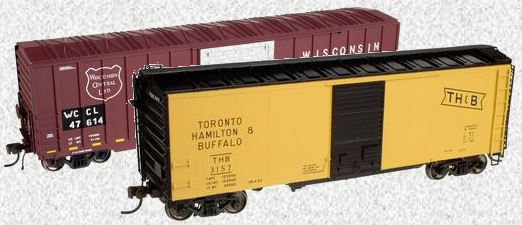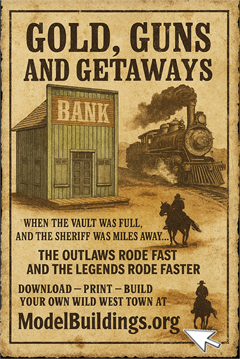Everything on model trains, model railroads, model railways, locomotives, model train layouts, scenery, wiring, DCC and more. Enjoy the world's best hobby... model railroading!
How Freight Yard Operations Will Provide Interest on a Model Railroad Layout
 A classification yard can be a hive of activity with trains arriving, departing, getting sorted throughout the day (and night). Depending on the yard type, size, and location; the arrival and departure schedule might include trains hauling bulk cargo, intermodal containers, refrigerated cargo, liquids, machinery, chemicals, fuels, vehicles, and/or plenty of general freight. Some consignments are easy to spot such as vehicles, but other cargo’s are less obvious without a closer look inside the wagons and cars.
A classification yard can be a hive of activity with trains arriving, departing, getting sorted throughout the day (and night). Depending on the yard type, size, and location; the arrival and departure schedule might include trains hauling bulk cargo, intermodal containers, refrigerated cargo, liquids, machinery, chemicals, fuels, vehicles, and/or plenty of general freight. Some consignments are easy to spot such as vehicles, but other cargo’s are less obvious without a closer look inside the wagons and cars.
Interesting Facts
Freight trains servicing an agricultural region could be transporting anything from soybeans, corn, wheat, fertilizers, chemicals, animal feed to even a new tractor or two. As an example; in 2012, the largest US railroads transported 1.4 million cars laden with grain. That was a staggering 4.9 % of the total cars hauled. Freight railroads in the US transport more corn than any other grain, although shipments of wheat are not far behind, followed by cargos of soybeans, and smaller cargos of oats, barley, rice, sorghum, rye, and other grains.
Other trains could be hauling processed or prepared foods such as canned produce, distiller grains, flour, soybean oil, frozen foods, or even corn syrup. In all, 2012 saw 2.1 million carloads of grains and grain food products hauled on major railroads in the US (7.5% of all carloads).
Much of the grain originated in South and North Dakota, Illinois, Kansas, Nebraska, and Minnesota. Most was destined for Washington, California, and Texas. The USA is a huge exporter of grain along with other countries including Australia, Brazil and Argentina.
The economics and practices of rail freight companies vary by region and country.
As export and domestic local markets have evolved, most railroads have improved their efficiency with shuttle trains and by changing the length of haulage. Since 1994, grain transportation has seen a change from smaller shipment sizes to larger “shuttle size” shipments of seventy five or more rail cars. This has lowered the costs and increased the number of local destinations that could unload shuttle size shipments. Altering the length of each haul has made the industry more competitive with road trucking companies.
 Rail yard buildings available from modelbuildings.org/low-relief-buildings-F.html
Rail yard buildings available from modelbuildings.org/low-relief-buildings-F.html
Fortunately there is still a place for rail transport in this modern world, and when operated efficiently railroads can compete effectively for the haulage of bulk cargoes over long distance.
Types of Rail Cars Use to Haul Freight
 I’ve already mentioned some of the freight types carried by rail transport, but what about the various types of cars likely to be spotted in a rail yard.
I’ve already mentioned some of the freight types carried by rail transport, but what about the various types of cars likely to be spotted in a rail yard.
Boxcars (also known as goods vans) will be one of the most common car in rail yards as they typically transport palleted or crated freight of varying sorts. In earlier days they were a common way to transport livestock, but ventilation was considered a problem. Boxcars have side doors for easy access by a forklift; some have end doors and even have adjustable bulkheads. They vary in size and features. Refrigerated boxcars feature temperature controls for perishable freight including vegetables, fresh fruit, frozen foods and more.
Covered hoppers freight shipments of loose dry bulk products. The hoppers can be loaded at the top and on arrival at the destination the product is then discharged at the bottom. Open top hoppers freight heavy bulk commodities that won’t be damaged by exposure to the weather.
Flatcars generally transport cargoes that are not easily damaged by wind, rain, or snow. They vary in length, and tonnage capacity, and are common in rail yards. Gondolas ship bulky commodities such as aggregates, scrap metal, lumber and logs.
Tank cars often don’t belong to the railroad that is transporting them. They are usually owned by the company that manufactures or distributes the products stored inside them. Some tank cars are pressurized and others are not. They typically transport liquid or gases.
Coil Cars transport steel plate, coiled steel, or even high grade ores. Center beams are used to move bundled building supplies and typically feature a center partition where the products are secured in position.
Automotive racks (Auto Racks) ship vehicles both imported and domestically produced. The vehicles are not always visible (depending on the auto rack design), but they ship anything from automobiles, to trucks, to tractors, to mini vans, and SUVs.
Although that’s not the complete list of cars you could potentially see moving or parked in a rail yard, it does include most of the main car types. I guess what I am leading to is; a rail yard can be a fascinating inclusion to any model railroad. There’s usually plenty of activity with trains arriving and departing. Little switcher engines hustle around shunting and sorting cars into a new consist ready for departure to the next destination.
 Warehouse buildings available from http://www.modelbuildings.org/low-relief-buildings-F.html
Warehouse buildings available from http://www.modelbuildings.org/low-relief-buildings-F.html
To add realism to a rail yard scene you need to include some related industries or warehouses nearby. However this needs to be done without taking up a lot of track space, otherwise the yard becomes cramped. Including an engine shed, or if you have space a roundhouse or turntable, will add to the scene. One solution is to position a series of buildings behind a rail yard to represent storage warehouses, factories, or freight forwarding companies that are likely to be located near a rail yard. These can be made as low relief structures or as flats with just the frontages visible.
Contribute your comments to this post.
If you enjoyed reading this article please share it with friends.
3 Responses to How Freight Yard Operations Will Provide Interest on a Model Railroad Layout
Leave a Reply















….I really enjoyed this entry. I am in the early stages {3 months in} of building my 2×6′ N scale layout and there will be a frieght yard at one end. This blog is just FANTASTIC! I am learning quite a bit every day……thanx ___________-dave
“Enjoy” is sure the word when it comes to the article on the Blog about different freight cars and the types of freight moved. This is vital stuff to making a model railroad look realistic, along with the AGE of the freight car. These cars can seemingly run forever (and look it), making them a challenge to modelers who weather their equipment, paint over the original markings, and/or “bang up” their cars to make them look well used like real life. It takes some research to find out where a certain freight car originally came from, making freight yards very interesting.
As an example of freight car types, where I lived in Wayne, New Jersey, when Conrail was in its heyday, there was a line that belonged originally (1950 is printed on the rails) to Delaware, Lackawanna, and Western, then Erie Lackawanna, then by their successor Conrail and NJ Transit for passenger service. Conrail used the line to run short freights, and I used to see box cars, covered hoppers, a caboose or two, a Wisconsin Central, Ltd. hopper that looked very new, and black-painted tank cars handwritten with white paint for maple syrup.
In the early-1990’s, at one end of Wayne Township, earth had to be taken from the area and moved at night to Jersey City.To do this, Conrail used a bunch of old open-top hoppers painted black and sporting a lot of rust and bare spots. Upon examination on a weekend afternoon when nobody was around and the hoppers were parked, I found that the hoppers were painted for Penn Central, with the aqua green paint showing through the bare spots on the black overcoat. As a train nut I was glad to see these cars still working, but I must have been the only one in the vicinity to see the job end. Those long strings of old hoppers made a rumble at night that sounded like an earthquake!
Hey, Dave. Good to talk to another N-Scaler.
Wish you good luck with your 2×6-foot. Here’s a tip on N-Scale that you may or may not have used:
If you’re going 2-foot wide, and if you’re making 2 tracks, the larger radius, usually 11″, will take you right to the edge of the table or board you’re using, too near where the train could easily fall off onto the floor. To remedy this, cut two one-inch by 6-foot boards, and secure them on each of the two sides where you have a 6-foot run. That gives you an inch on each side to catch the train if it falls, especially if you fill the one-inch widths with rocks, trees, ground cover, etc. If you want to, you can make two trains – two ovals of track; 11″ Radius on the outside and 9-3/4″ Radius on the inside.